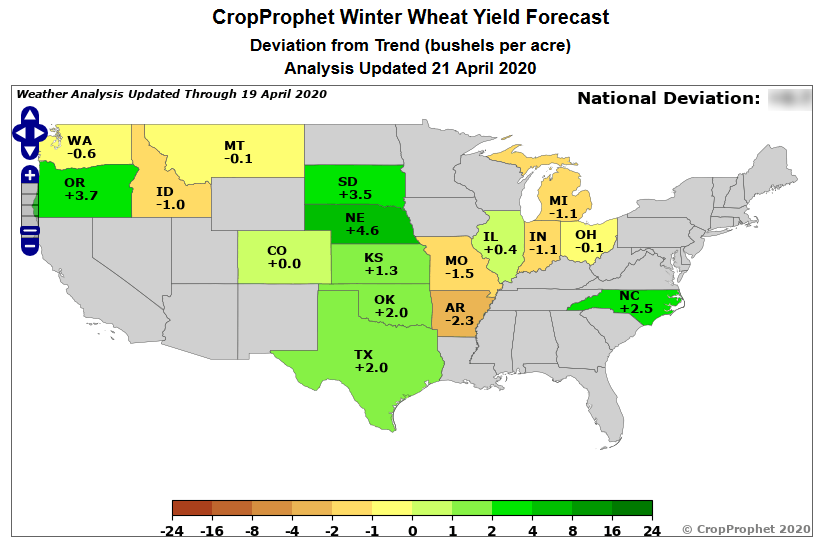Winter Wheat Yield Forecast Commentary
CropProphet releases a bi-weekly crop commentary focused on the analysis of the winter wheat yield forecast during the early winter wheat season each spring and a weekly crop commentary during the corn and soybean growing season in the US. The information below is the “best of April” CropProphet crop commentary.
CropProphet is available to trial for free. Use the form a right to request a trial.
Winter Wheat Commentary: April 21, 2020
As the start of the 2020 growing season advances northward across the U.S., CropProphet forecasts for winter wheat are providing quantitative winter wheat yield forecasts and production forecasts at the county, state, and national levels where winter wheat is grown. Daily updates are released based on the latest weather data, and additional predictive value is gained from the weekly crop condition reports issued by the USDA. By early May the skill of the CropProphet U.S. yield forecast is competitive with the mid-May USDA estimate, and therefore CropProphet provides useful advance information on the likely crop outcome.
In the weeks since CropProphet was launched for the new season, the winter wheat yield outlook has been buoyed by above-normal USDA crop condition estimates in many of the top growing states, and particularly from Texas to South Dakota. The strong crop ratings are a reflection of a very mild winter, with adequate rainfall and soil moisture in most of the central U.S. (see below).



In the past few weeks, unusually cold weather with widespread late spring freezes in the central and northern Plains has caused some deterioration in the USDA ratings, but even after these declines, the reported crop condition remains generally good, and the strong crop ratings are the primary reason for the above-trend yields that CropProphet currently expects in the Plains. The greatest yield surplus is currently found in Nebraska, where the USDA crop condition is far better than normal (and similar to last year at the same date).

The recent cold weather does give cause for concern with regards to the winter wheat yield forecast, however. Cold has been remarkably intense for the time of year in the central U.S., with temperatures averaging about 15°F below normal in the central Plains in the past week (see below). In Kansas, the top winter wheat growing state, the average temperature for the middle 10 days of April has been the second coldest on record (1981-present), trailing only 2013.
Freeze damage has undoubtedly occurred in some areas where crop development is relatively advanced; for example, 81% of Oklahoma winter wheat acreage has seen temperatures below 30°F (-1°C) in the past 10 days, and the USDA reports that 28% of the state’s crop was already in the sensitive heading phase by last weekend. Damage is also likely to have occurred in northern Texas.

CropProphet uses several freeze predictors to capture the impacts of damaging spring frost on winter wheat, and it is likely that the county-level forecasts will show some deterioration in yield and production over the next few weeks in areas where freezing conditions affected relatively mature wheat fields. The delay in CropProphet’s response to the freeze is related to the process for estimating crop maturity; CropProphet relies on the USDA crop progress at later dates to obtain more accurate estimates of the state of the crop at the time of the freeze. For now, the CropProphet county forecasts only show modest yield declines in parts of Kansas, Colorado, and the Texas and Oklahoma panhandles.

According to CropProphet, total U.S. production of winter wheat is likely to be near x.xx [data removed to protect our subscribers] billion bushels, with a central 50% confidence interval of 1.xx-1.xx [data removed to protect our subscribers] billion bushels. With the exception of 2018, this would be the lowest national production since the drought year of 2002, and the ongoing trend towards lower acreage is partly to blame; the USDA reports the lowest planted acreage for U.S. winter wheat since 1971.